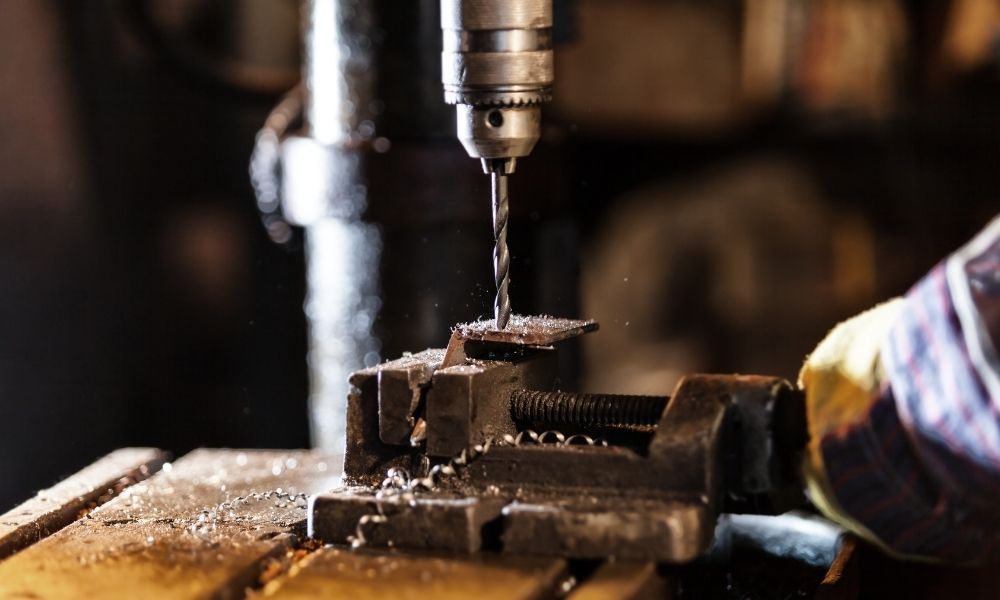A drill press is an indispensable tool in any workshop, offering unparalleled accuracy, power, and versatility in drilling operations. Whether you’re a seasoned craftsman or a DIY enthusiast, mastering the art of using a drill press can significantly enhance your woodworking, metalworking, or home improvement projects. Understanding its capabilities, nuances, and proper techniques is crucial for achieving precise and professional results.
Understanding the Drill Press
A drill press is a quintessential stationary machine renowned for its ability to create meticulously precise and consistent holes. Its construction typically comprises several fundamental components:
- Base: The foundation of the drill press provides stability and support.
- Column: This vertical pillar supports the motor and guides the movement of the spindle and drill bit.
- Motor: Powers the drill press, providing the necessary force for drilling.
- Spindle: Holds and rotates the drill bit, enabling it to penetrate the material.
- Chuck: Clamps onto the drill bit securely, allowing for smooth rotation and control.
- Worktable: Provides a surface for the material being drilled and can be adjusted for height, angle, and rotation.
- Depth Stop: Helps regulate the depth of the drilled holes, ensuring uniformity.
- Speed Settings: Enable adjustment of the rotational speed of the spindle, crucial for various materials and bit sizes.
The drill press’s design and components combine to deliver accuracy, stability, and control, making it a versatile tool for woodworking, metalworking, and other precision tasks.
Choosing the Right Drill Press

Selecting the ideal drill press involves evaluating multiple factors:
- Horsepower: Higher horsepower provides more drilling power, crucial for tougher materials.
- Speed Range: A variable speed range accommodates different materials and bit sizes.
- Chuck Size: Determines the maximum bit size the drill press can accommodate.
- Throat Depth: The distance from the column to the center of the spindle, impacts the capacity for drilling large materials.
Consider the nature and scale of your projects. A benchtop drill press suits smaller tasks and limited space, while a floor-standing model offers higher power and stability for larger, more demanding projects.
Setting Up Your Drill Press
Achieving precision begins with a well-prepared drill press setup:
- Stability: Anchor the drill press securely to a robust surface to prevent vibration and ensure stability during operation.
- Alignment: Properly align the table and fence to ensure accuracy in drilling.
- Chuck Tightness: Check and secure the chuck to prevent slippage or wobbling during drilling.
- Bit Selection: Choose the appropriate drill bit based on the material and hole size required.
Safety Precautions
Prioritize safety to prevent accidents while operating the drill press:
- Protective Gear: Wear safety goggles, avoid loose clothing or jewelry, and tie back long hair.
- Workpiece Stability: Use clamps or a vise to secure the workpiece firmly in place to prevent movement during drilling.
- Safe Handling: Always switch off the drill press before making adjustments or changing bits.
Techniques for Precision Drilling
Achieving precision involves mastering several techniques:
- Speed Settings: Adjust the speed according to the manufacturer’s recommendations or through trial and error for different materials.
- Depth Control: Utilize the depth stop to maintain consistent hole depths, preventing over-drilling.
- Clamping and Positioning: Securely clamp the workpiece and use layout tools for accurate hole placement.
- Lubrication: Applying lubricant while drilling metals reduces friction, heat, and wear on the bit.
Maintenance and Care
Maintaining your drill press ensures its longevity and optimal performance:
- Cleaning: Regularly clean the machine to remove debris and dust buildup.
- Lubrication: Keep moving parts well-lubricated to prevent friction and wear.
- Check Belts and Bits: Inspect belts for tension and replace worn or damaged bits promptly.
Advanced Techniques and Accessories
Exploring advanced techniques and accessories can expand the capabilities of your drill press:
- Countersinking: Create indentations for screws to sit flush with the material’s surface.
- Mortising: Cut square or rectangular holes for joints using a mortising attachment.
- Specialty Drill Bits: Utilize specialty bits for specific tasks like forstner bits for clean, flat-bottomed holes.
- Accessories: Attachments such as drum sanders and rotary sanding drums enhance the drill press’s versatility for sanding and shaping tasks.
Conclusion
Mastering the use of a drill press empowers craftsmen and DIY enthusiasts to achieve precise, high-quality results in their projects. By understanding its functionalities, following safety protocols, employing proper techniques, and exploring advanced capabilities, you can unlock the full potential of this indispensable tool.
Whether you’re drilling through wood, metal, or other materials, the drill press stands as a cornerstone for precision, power, and performance in your workshop. With practice and attention to detail, you’ll soon become adept at harnessing the full capabilities of this invaluable tool.
